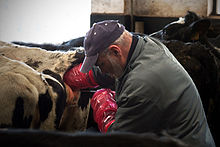In animals

AI is used for pets, livestock, endangered species, and animals in zoos or marine parks difficult to transport.
Reasons and techniquesedit
It may be used for many reasons, including to allow a male to inseminate a much larger number of females, to allow the use of genetic material from males separated by distance or time, to overcome physical breeding difficulties, to control the paternity of offspring, to synchronize births, to avoid injury incurred during natural mating, and to avoid the need to keep a male at all (such as for small numbers of females or in species whose fertile males may be difficult to manage).
Semen is collected, extended, then cooled or frozen. It can be used on-site or shipped to the female's location. If frozen, the small plastic tube holding the semen is referred to as a straw. To allow the sperm to remain viable during the time before and after it is frozen, the semen is mixed with a solution containing glycerol or other cryoprotectants. An extender is a solution that allows the semen from a donor to impregnate more females by making insemination possible with fewer sperm. Antibiotics, such as streptomycin, are sometimes added to the sperm to control some bacterial venereal diseases. Before the actual insemination, estrus may be induced through the use of progestogen and another hormone (usually PMSG or Prostaglandin F2α).
Historyedit
The first viviparous animal to be artificially fertilized was a dog. The experiment was conducted with success by the Italian Lazzaro Spallanzani in 1780. Another pioneer was the Russian Ilya Ivanov in 1899. In 1935, diluted semen from Suffolk sheep was flown from Cambridge in Britain to Kraków, Poland, as part of an international research project.citation needed The participants included Prawochenki (Poland), Milovanoff (USSR), Hammond and Walton (UK), and Thomasset (Uruguay).
Modern artificial insemination was pioneered by John O. Almquist of Pennsylvania State University. He improved breeding efficiency by the use of antibiotics (first proven with penicillin in 1946) to control bacterial growth, decreasing embryonic mortality, and increase fertility. This, and various new techniques for processing, freezing, and thawing of frozen semen significantly enhanced the practical utilization of AI in the livestock industry and earned him the 1981 Wolf Foundation Prize in Agriculture. Many techniques developed by him have since been applied to other species, including humans.
Speciesedit
Artificial insemination is used in many non-human animals, including sheep, horses, cattle, pigs, dogs, pedigree animals generally, zoo animals, turkeys and creatures as tiny as honeybees and as massive as orcas (killer whales).
Artificial insemination of farm animals is common in the developed world, especially for breeding dairy cattle (75% of all inseminations). Swine are also bred using this method (up to 85% of all inseminations). It is an economical means for a livestock breeder to improve their herds utilizing males having desirable traits. This procedure is condemned by animal rights campaigners such as People for the Ethical Treatment of Animals and Joey Carbstrong, who identify the practice as a form of rape due to its sexual, involuntary and perceived painful nature.
Although common with cattle and swine, AI is not as widely practiced in the breeding of horses. A small number of equine associations in North America accept only horses that have been conceived by "natural cover" or "natural service" – the actual physical mating of a mare to a stallion – the Jockey Club being the most notable of these, as no AI is allowed in Thoroughbred breeding. Other registries such as the AQHA and warmblood registries allow registration of foals created through AI, and the process is widely used allowing the breeding of mares to stallions not resident at the same facility – or even in the same country – through the use of transported frozen or cooled semen.
In modern species conservation, semen collection and artificial insemination are used also in birds. In 2013 scientist of the Justus-Liebig-University of Giessen, Germany, from the working group of Michael Lierz, Clinic for birds, reptiles, amphibians, and fish, developed a novel technique for semen collection and artificial insemination in parrots producing the world's first macaw by assisted reproduction.
Scientists working with captive orcas were able to pioneer the technique in the early 2000s, resulting in "the first successful conceptions, resulting in live offspring, using artificial insemination in any cetacean species". John Hargrove, a SeaWorld trainer, describes Kasatka as being the first orca to receive AI.
Animal rights concernsedit
AI on animals are often considered violation of animal rights, and scholars and animal rights advocates equate it with rape and institutionalized bestiality. Animal rights organizations such as PETA and Mercy for Animals frequently write against the practice in their articles. Much of the meat production in the United States depends on AI, resulting in an explosive growth of the procedure over the past three decades. The state of Kansas makes no exceptions for AI under its bestiality law, thus making the procedure illegal.
Comments
Post a Comment